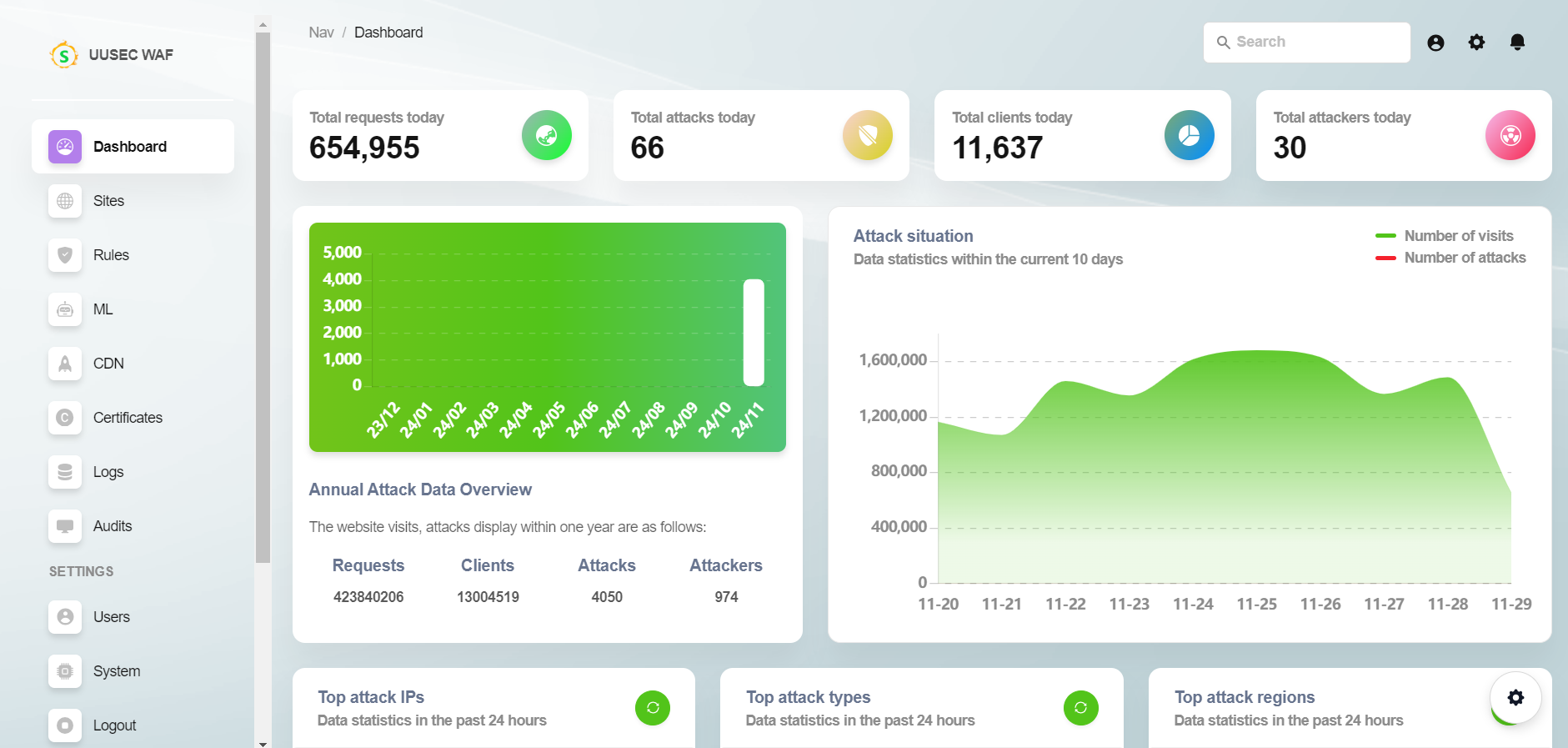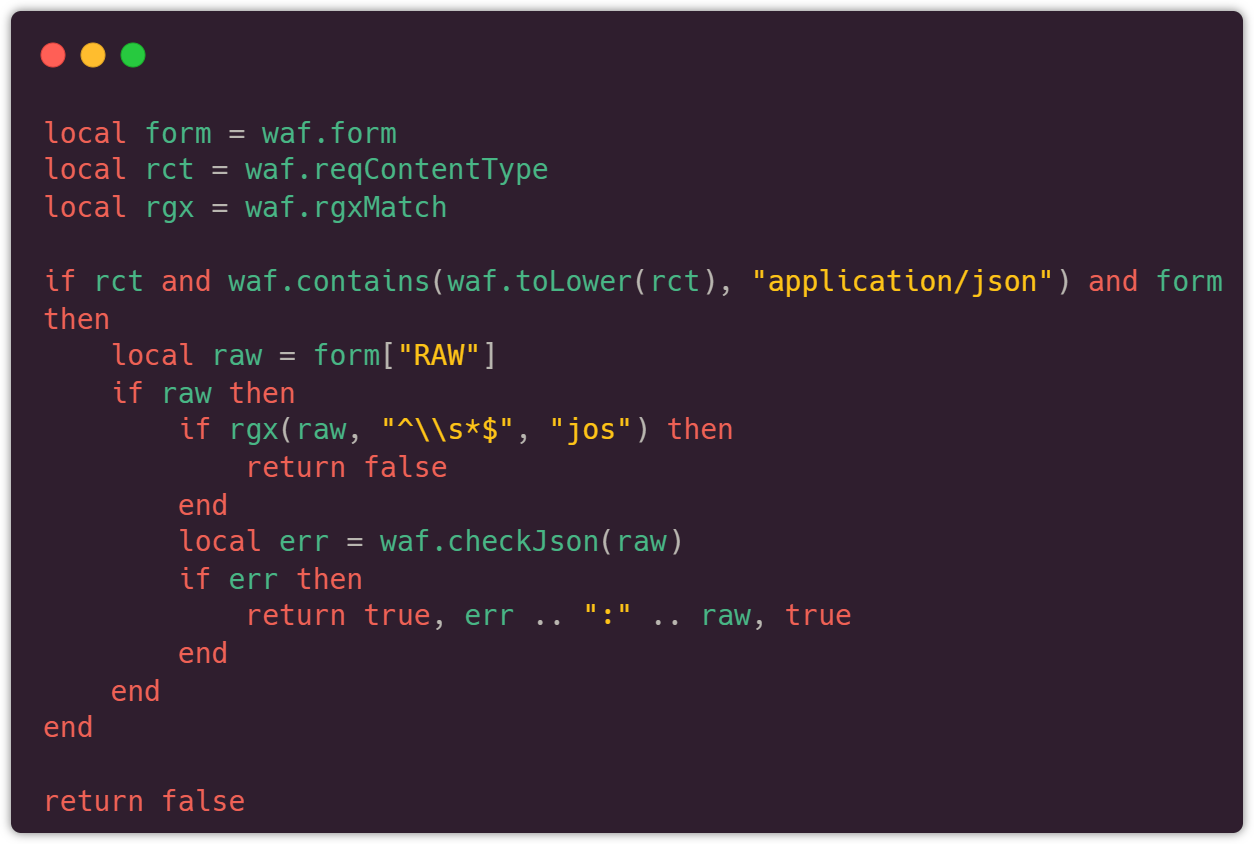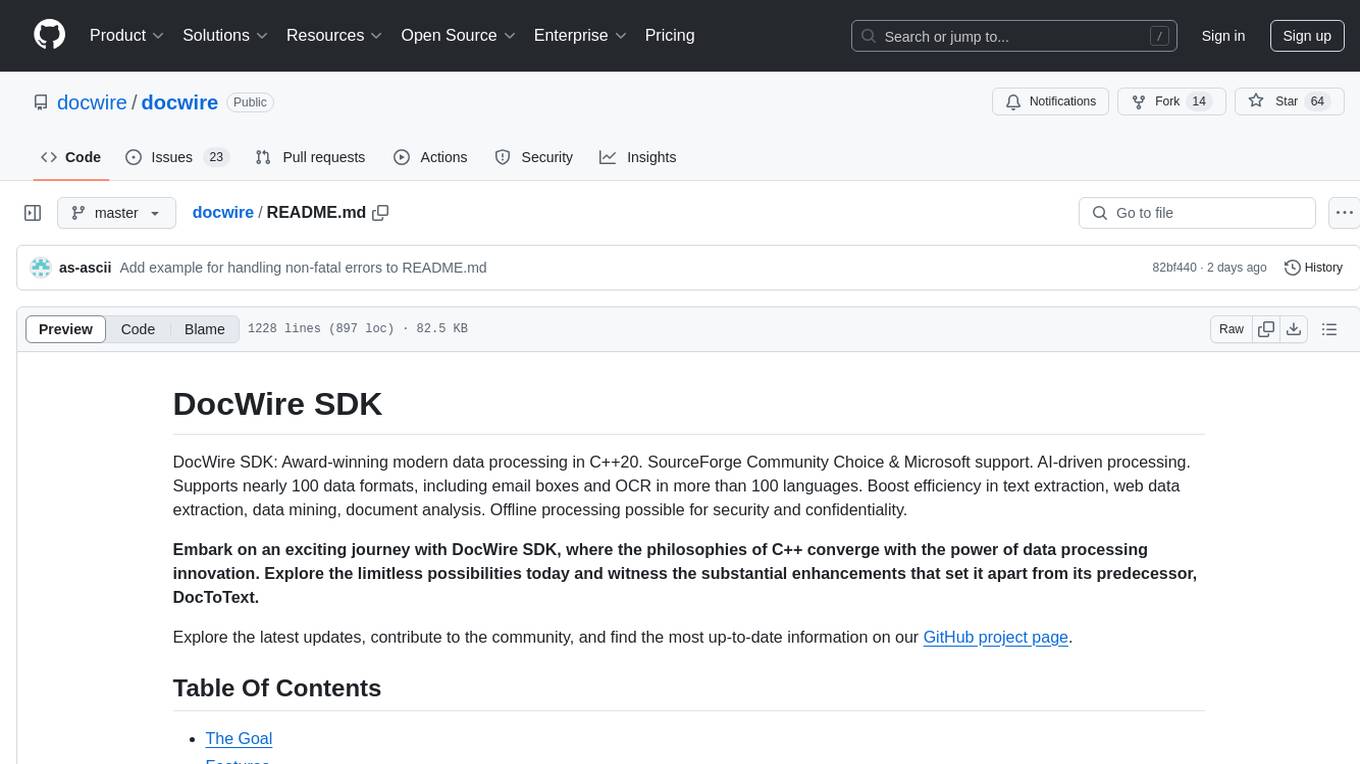
uuWAF
An industry-leading free, high-performance, AI and semantic technology Web Application Firewall and API Security Gateway (WAAP) - UUSEC WAF.
Stars: 1062
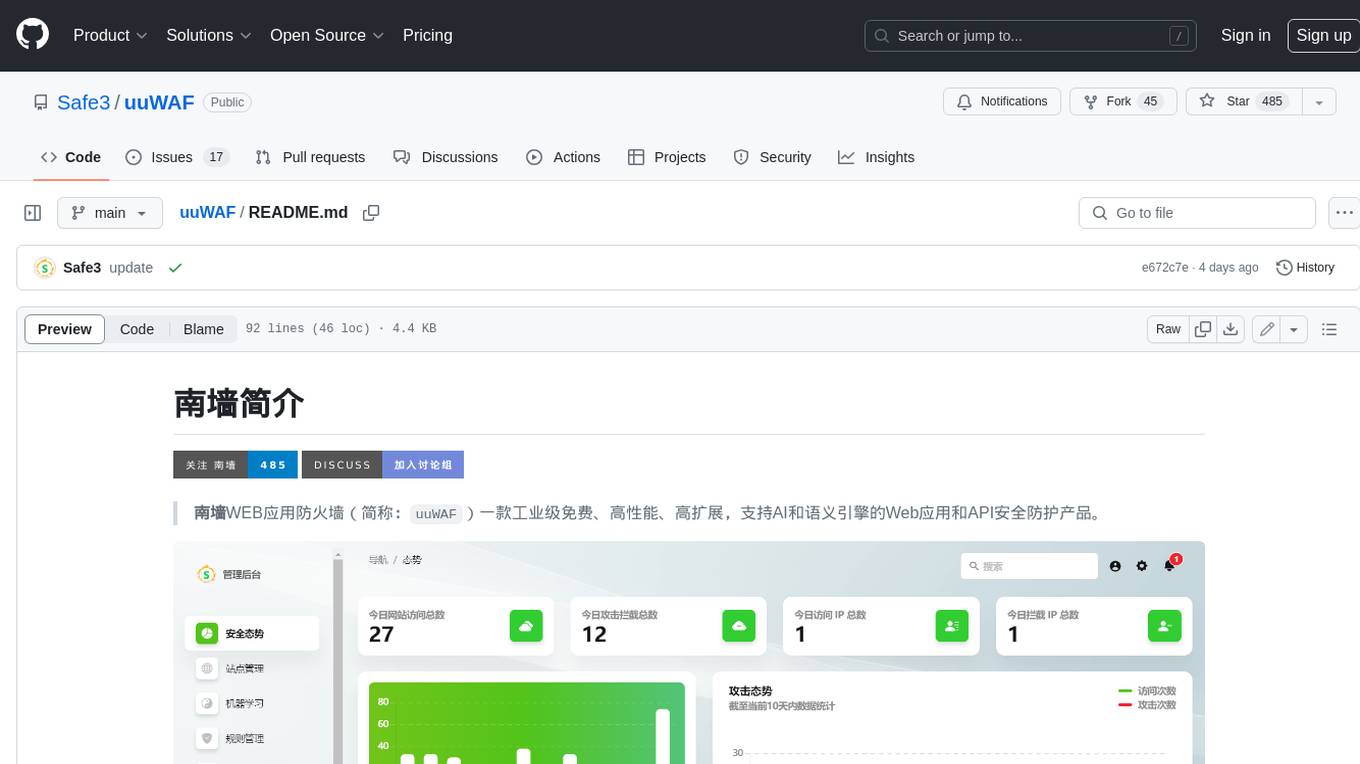
uuWAF is an industrial-grade, free, high-performance, highly extensible web application and API security protection product that supports AI and semantic engines.
README:
🏠 Website |
中文版
⭐Please help us with a star to support our continuous improvement, thank you!
UUSEC WAF Web Application Firewall is an industrial grade free, high-performance, and highly scalable web application and API security protection product that supports AI and semantic engines. It is a comprehensive website protection product launched by UUSEC Technology, which first realizes the three-layer defense function of traffic layer, system layer, and runtime layer.
⛎ Intelligent 0-day defense
UUSEC WAF innovatively applies machine learning technology, using anomaly detection algorithms to distinguish and identify HTTP normal and attack traffic, and models whitelist threats to normal traffic. By using machine learning algorithms to automatically learn the parameter characteristics of normal traffic and convert them into corresponding parameter whitelist rule libraries, it is possible to intercept attacks without adding rules when facing various sudden 0-day vulnerabilities, eliminating the pain of website managers having to work late to upgrade as soon as vulnerabilities appear.
♉ Ultimate CDN acceleration
UUSEC self-developed cache cleaning feature surpasses the arbitrary cache cleaning function only available in the commercial version of nginx, proxy_cache_purge. The commercial version of nginx only supports * pattern matching to clean the cache, while UUSEC WAF further supports regular expression matching URL path cache cleaning, which has higher flexibility and practicality compared to the commercial version of nginx. Users can enjoy ultimate CDN acceleration while more conveniently solving cache expiration issues.
♍ Powerful proactive defense
The self-developed 'HIPS' and 'RASP' functions of UUSEC WAF can achieve more powerful dual layer defense at the system layer and application runtime layer, effectively preventing zero day vulnerability attacks. Host layer active defense can intercept low-level attacks at the system kernel layer, such as restricting process network communication, process creation, file read and write, system privilege escalation, system overflow attacks, etc. Runtime application self-defense RASP is inserted into runtime engines such as Java JVM and PHP Zend to effectively track runtime context and intercept various web 0-day vulnerability attacks.
♎ Advanced semantic engine
UUSEC WAF adopts four industry-leading semantic analysis based detection engines, namely SQL, XSS, RCE, and LFI. Combined with multiple deep decoding engines, it can truly restore HTTP content such as base64, JSON, and form data, effectively resisting various attack methods that bypass WAF. Compared with traditional regular matching, it has the characteristics of high accuracy, low false alarm rate, and high efficiency. Administrators do not need to maintain a complex rule library to intercept multiple types of attacks.
♊ Advanced rule engine
UUSEC WAF actively utilizes the high-performance and highly flexible features of nginx and luajit. In addition to providing a traditional rule creation mode that is user-friendly for ordinary users, it also offers a highly scalable and flexible Lua script rule writing function, allowing advanced security administrators with certain programming skills to create a series of advanced vulnerability protection rules that traditional WAF cannot achieve. Users can write a series of plugins to extend the existing functions of WAF. This makes it easier to intercept complex vulnerabilities.
UUSEC WAF provides you with a powerful and flexible API for extending and writing security rules. After being published in the management backend, all rules take effect immediately without restarting, far exceeding most free WAF products on the market such as ModSecurity. The rules are shown below:
🏠Please visit the official website to see more details: https://uuwaf.uusec.com/
[!WARNING] 中国用户请访问 中文官网 安装中文版,以下步骤安装国际版可能会导致无法使用!
The installation of the UUSEC WAF is very simple, usually completed within a few minutes, and the specific time depends on the network download situation.
Attention: Please try to choose a pure Linux x86_64 environment server for installation, as the installation process will uninstall the old MySQL database and reinstall it. If there is no backup, it may cause the loss of old MySQL data. In addition, the UUSEC WAF adopts cloud WAF reverse proxy mode, which requires the use of ports 80 and 443 by default.
The host version installation:
- System requirements: RHEL 7 and above are compatible with x86_64 systems, such as CentOS, Rocky Linux, AlmaLinux, etc.
sudo yum install -y ca-certificates
curl https://uuwaf.uusec.com/waf-install -o waf-install && sudo bash ./waf-install && rm -f ./waf-installAfter successful installation, it will display "Congratulations, successful installation".
The docker version installation:
- Software dependencies: Docker version 20.10.14 or above, Docker Compose version 2.0.0 or above, lower versions may cause SQL data to be unable to be imported, resulting in login issues in the UUSEC WAF management.
If you encounter the inability to automatically install Docker Engine, please install it manually.
curl https://uuwaf.uusec.com/waf.tgz -o waf.tgz && tar -zxf waf.tgz && sudo bash ./waf/uuwaf.shSubsequently, bash ./waf/uuwaf.sh is used to manage the UUSEC WAF container, including starting, stopping, updating, uninstalling, etc.
Quick Start:
- Login to the management: Access https://ip:4443 ,the IP address is the server IP address for installing the UUSEC WAF, the default username is "admin", and the default password is "Passw0rd!".
- Add a site: Go to the "Sites" menu, click the "Add Site" button, and follow the prompts to add the site domain name and website server IP.
- Add SSL certificate: Go to the certificate management menu, click the "Add Certificate" button, and upload the HTTPS certificate and private key file of the domain name. If you do not add an SSL certificate, the UUSEC WAF will automatically attempt to apply for a Let's Encrypt free SSL certificate and renew it automatically before the certificate expires.
- Change the DNS address of the domain: Go to the domain name service provider's management backend and change the IP address recorded in the DNS A of the domain name to the IP address of the UUSEC WAF server.
- Test connectivity: Visit the site domain to see if the website can be opened, and check if the returned HTTP header server field is uuWAF.
For more solutions to problems encountered during use, please refer to FAQ.
For reference only
| Metric | ModSecurity, Level 1 | CloudFlare, Free | UUSEC WAF, Free | UUSEC WAF, Pro |
|---|---|---|---|---|
| Total Samples | 33669 | 33669 | 33669 | 33669 |
| Detection | 69.74% | 10.70% | 74.77% | 98.97% |
| False Positive | 17.58% | 0.07% | 0.09% | 0.01% |
| Accuracy | 82.20% | 98.40% | 99.42% | 99.95% |
How to contribute? reference: https://uuwaf.uusec.com/#/guide/contribute
Thanks to puhui222, MCQSJ, k4n5ha0 and more for the contribution made to the UUSEC WAF!
Welcome to participate in discussions on various bugs, functional requirements, and usage issues related to the UUSEC WAF through the following channels:
- Problem submission: https://github.com/Safe3/uuWAF/issues
- Discussion Community: https://github.com/Safe3/uuWAF/discussions
For Tasks:
Click tags to check more tools for each tasksFor Jobs:
Alternative AI tools for uuWAF
Similar Open Source Tools

uuWAF
uuWAF is an industrial-grade, free, high-performance, highly extensible web application and API security protection product that supports AI and semantic engines.
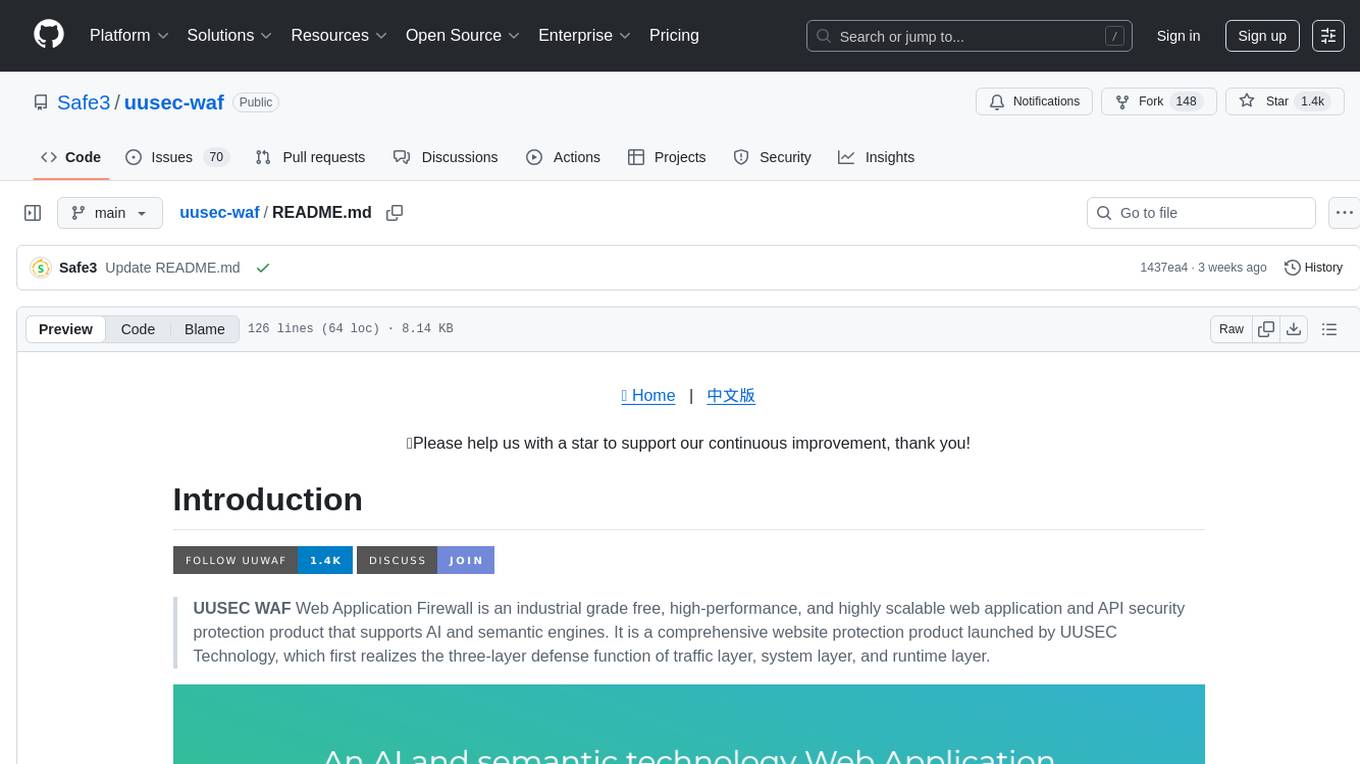
uusec-waf
UUSEC WAF is an industrial grade free, high-performance, and highly scalable web application and API security protection product that supports AI and semantic engines. It provides intelligent 0-day defense, ultimate CDN acceleration, powerful proactive defense, advanced semantic engine, and advanced rule engine. With features like machine learning technology, cache cleaning, dual layer defense, semantic analysis, and Lua script rule writing, UUSEC WAF offers comprehensive website protection with three-layer defense functions at traffic, system, and runtime layers.
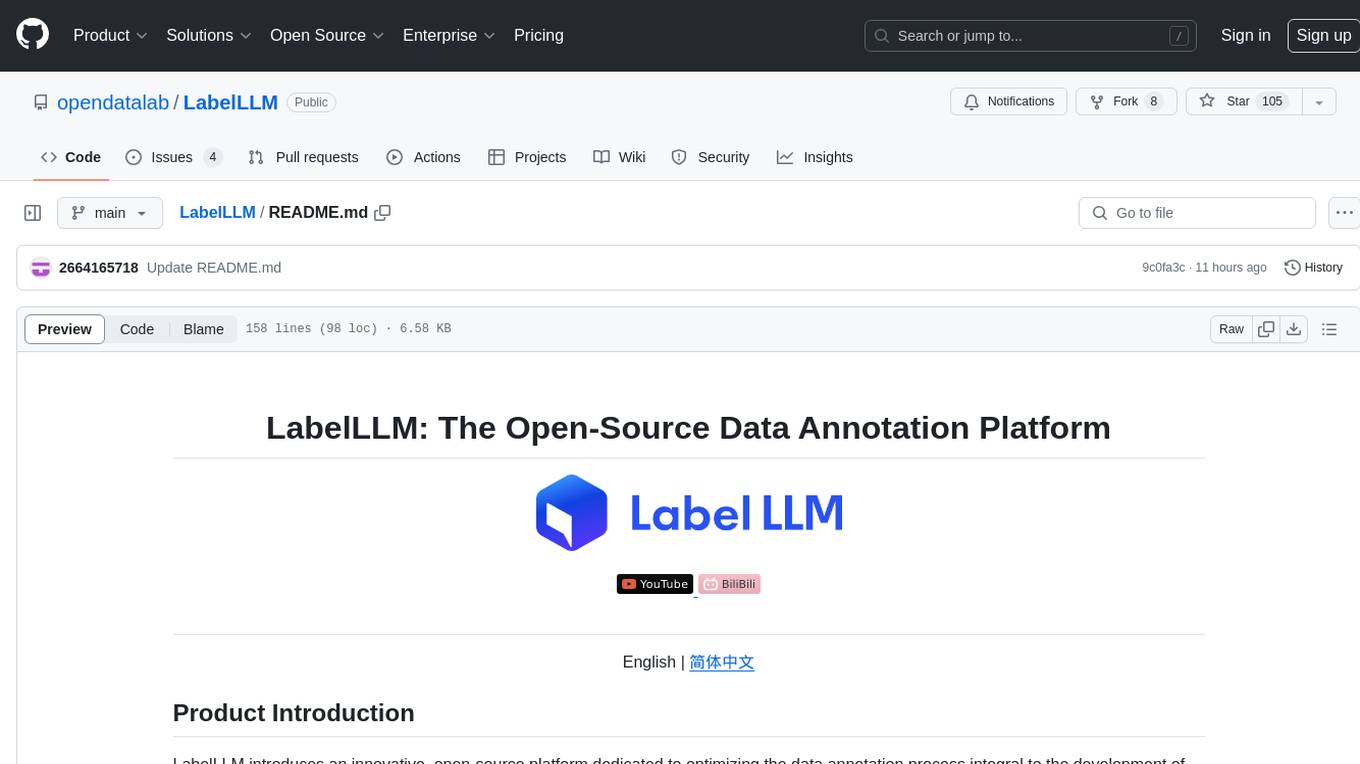
LabelLLM
LabelLLM is an open-source data annotation platform designed to optimize the data annotation process for LLM development. It offers flexible configuration, multimodal data support, comprehensive task management, and AI-assisted annotation. Users can access a suite of annotation tools, enjoy a user-friendly experience, and enhance efficiency. The platform allows real-time monitoring of annotation progress and quality control, ensuring data integrity and timeliness.
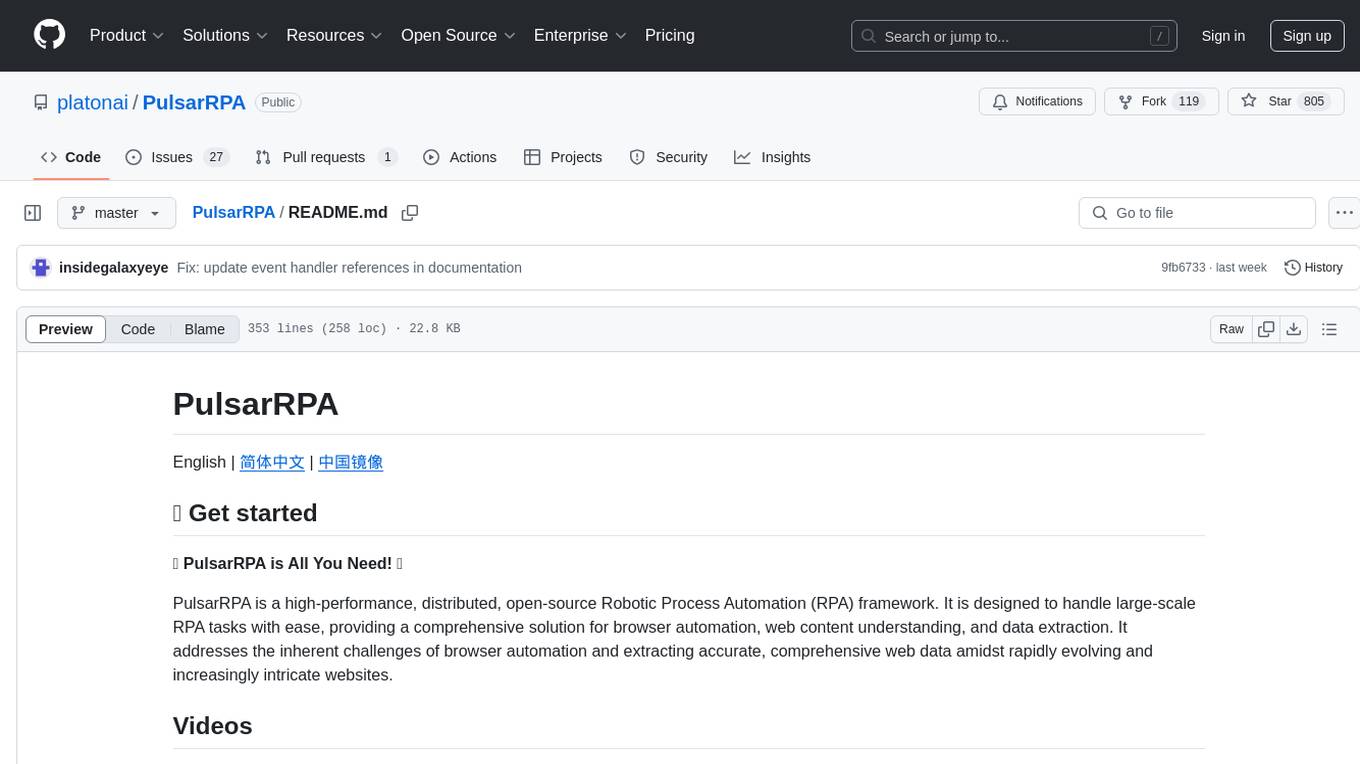
PulsarRPA
PulsarRPA is a high-performance, distributed, open-source Robotic Process Automation (RPA) framework designed to handle large-scale RPA tasks with ease. It provides a comprehensive solution for browser automation, web content understanding, and data extraction. PulsarRPA addresses challenges of browser automation and accurate web data extraction from complex and evolving websites. It incorporates innovative technologies like browser rendering, RPA, intelligent scraping, advanced DOM parsing, and distributed architecture to ensure efficient, accurate, and scalable web data extraction. The tool is open-source, customizable, and supports cutting-edge information extraction technology, making it a preferred solution for large-scale web data extraction.
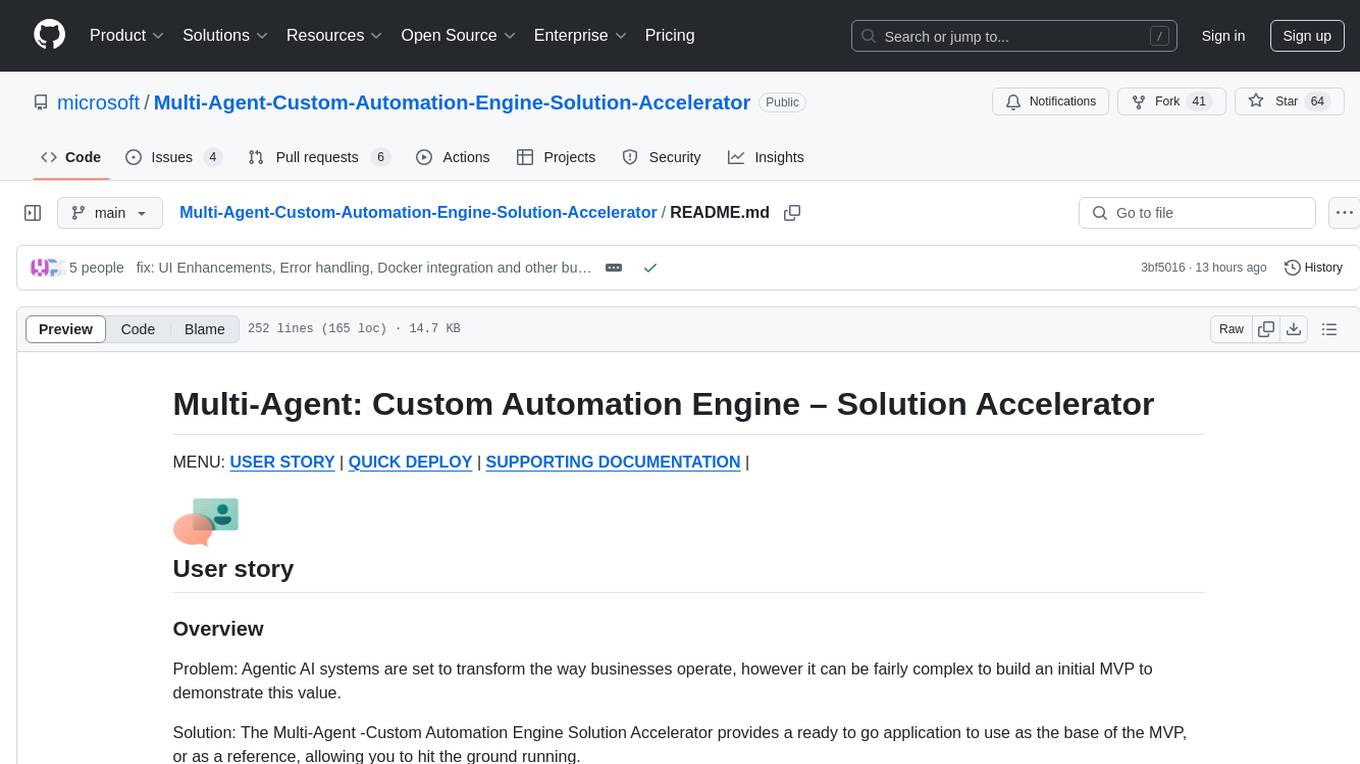
Multi-Agent-Custom-Automation-Engine-Solution-Accelerator
The Multi-Agent -Custom Automation Engine Solution Accelerator is an AI-driven orchestration system that manages a group of AI agents to accomplish tasks based on user input. It uses a FastAPI backend to handle HTTP requests, processes them through various specialized agents, and stores stateful information using Azure Cosmos DB. The system allows users to focus on what matters by coordinating activities across an organization, enabling GenAI to scale, and is applicable to most industries. It is intended for developing and deploying custom AI solutions for specific customers, providing a foundation to accelerate building out multi-agent systems.
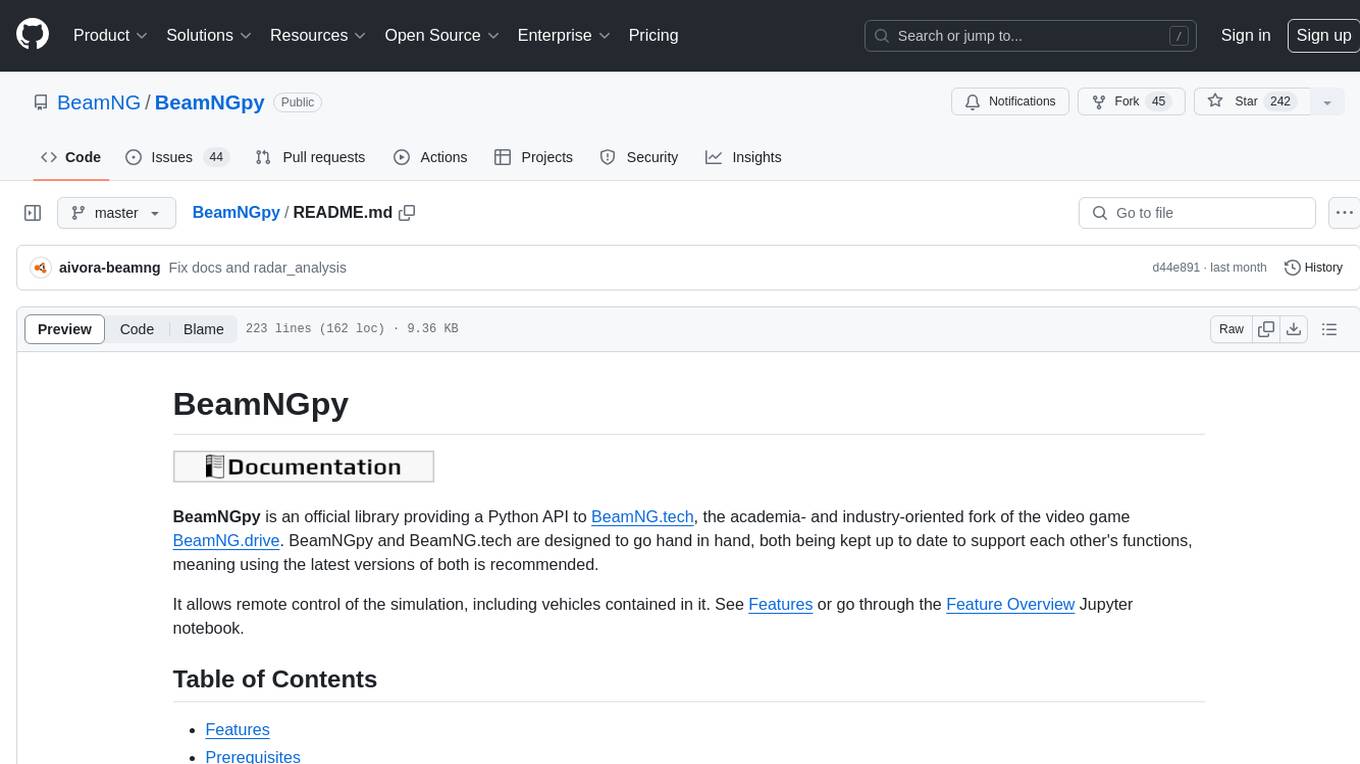
BeamNGpy
BeamNGpy is an official Python library providing an API to interact with BeamNG.tech, a video game focused on academia and industry. It allows remote control of vehicles, AI-controlled vehicles, dynamic sensor models, access to road network and scenario objects, and multiple clients. The library comes with low-level functions and higher-level interfaces for complex actions. BeamNGpy requires BeamNG.tech for usage and offers compatibility information for different versions. It also provides troubleshooting tips and encourages user contributions.
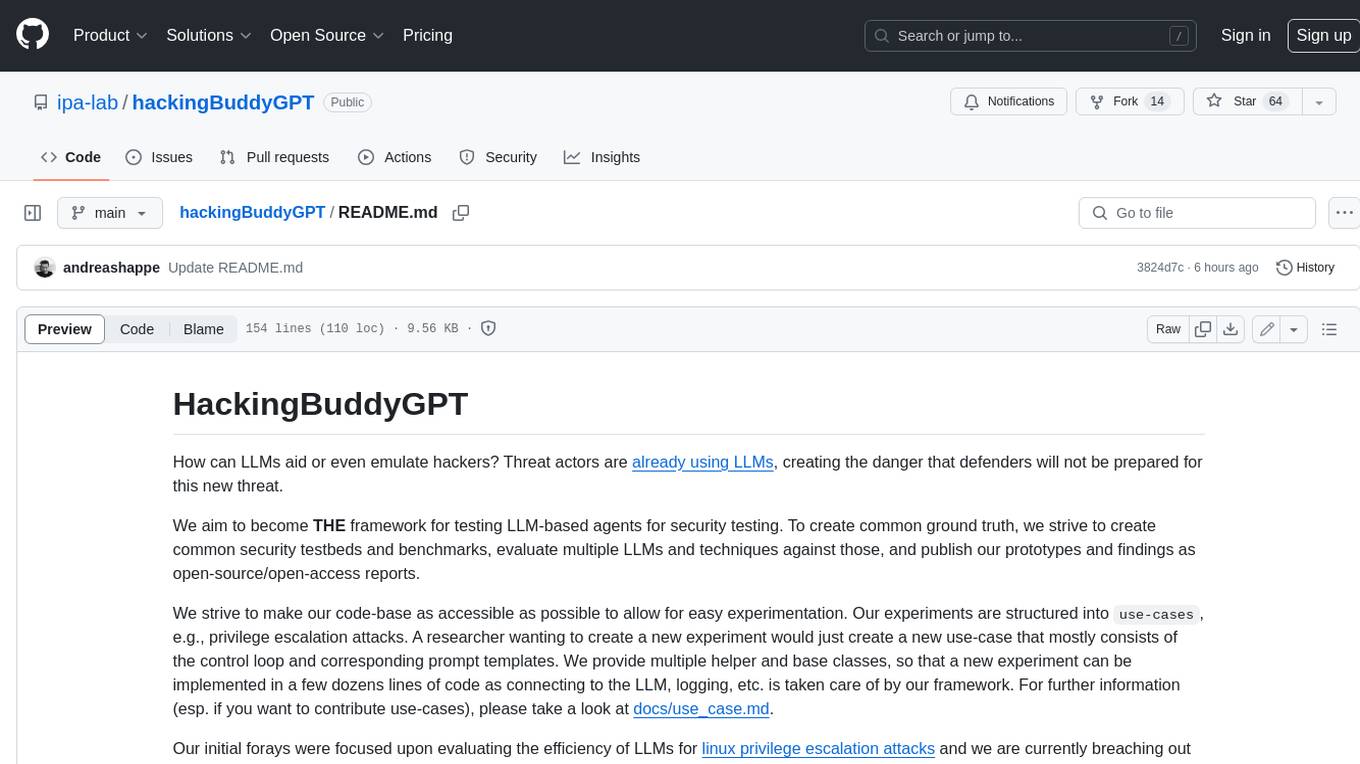
hackingBuddyGPT
hackingBuddyGPT is a framework for testing LLM-based agents for security testing. It aims to create common ground truth by creating common security testbeds and benchmarks, evaluating multiple LLMs and techniques against those, and publishing prototypes and findings as open-source/open-access reports. The initial focus is on evaluating the efficiency of LLMs for Linux privilege escalation attacks, but the framework is being expanded to evaluate the use of LLMs for web penetration-testing and web API testing. hackingBuddyGPT is released as open-source to level the playing field for blue teams against APTs that have access to more sophisticated resources.
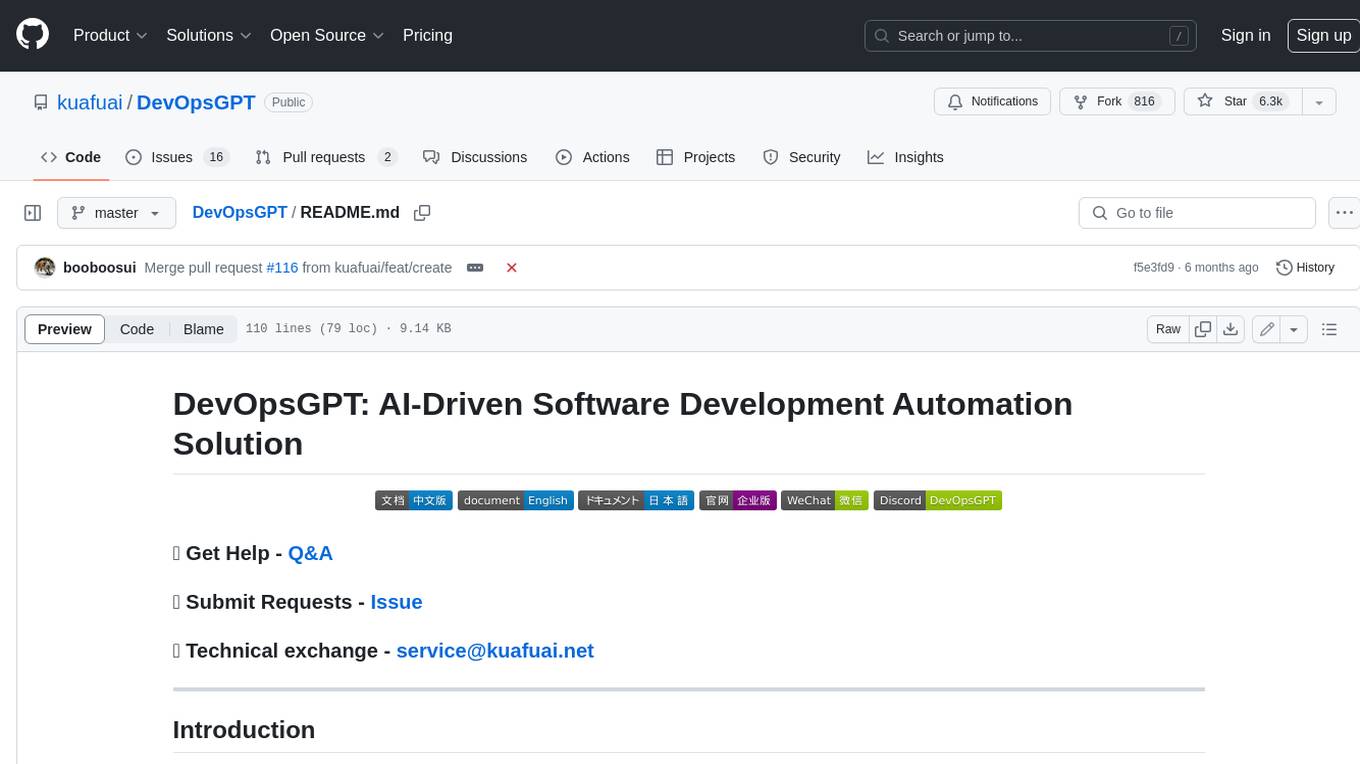
DevOpsGPT
DevOpsGPT is an AI-driven software development automation solution that combines Large Language Models (LLM) with DevOps tools to convert natural language requirements into working software. It improves development efficiency by eliminating the need for tedious requirement documentation, shortens development cycles, reduces communication costs, and ensures high-quality deliverables. The Enterprise Edition offers features like existing project analysis, professional model selection, and support for more DevOps platforms. The tool automates requirement development, generates interface documentation, provides pseudocode based on existing projects, facilitates code refinement, enables continuous integration, and supports software version release. Users can run DevOpsGPT with source code or Docker, and the tool comes with limitations in precise documentation generation and understanding existing project code. The product roadmap includes accurate requirement decomposition, rapid import of development requirements, and integration of more software engineering and professional tools for efficient software development tasks under AI planning and execution.
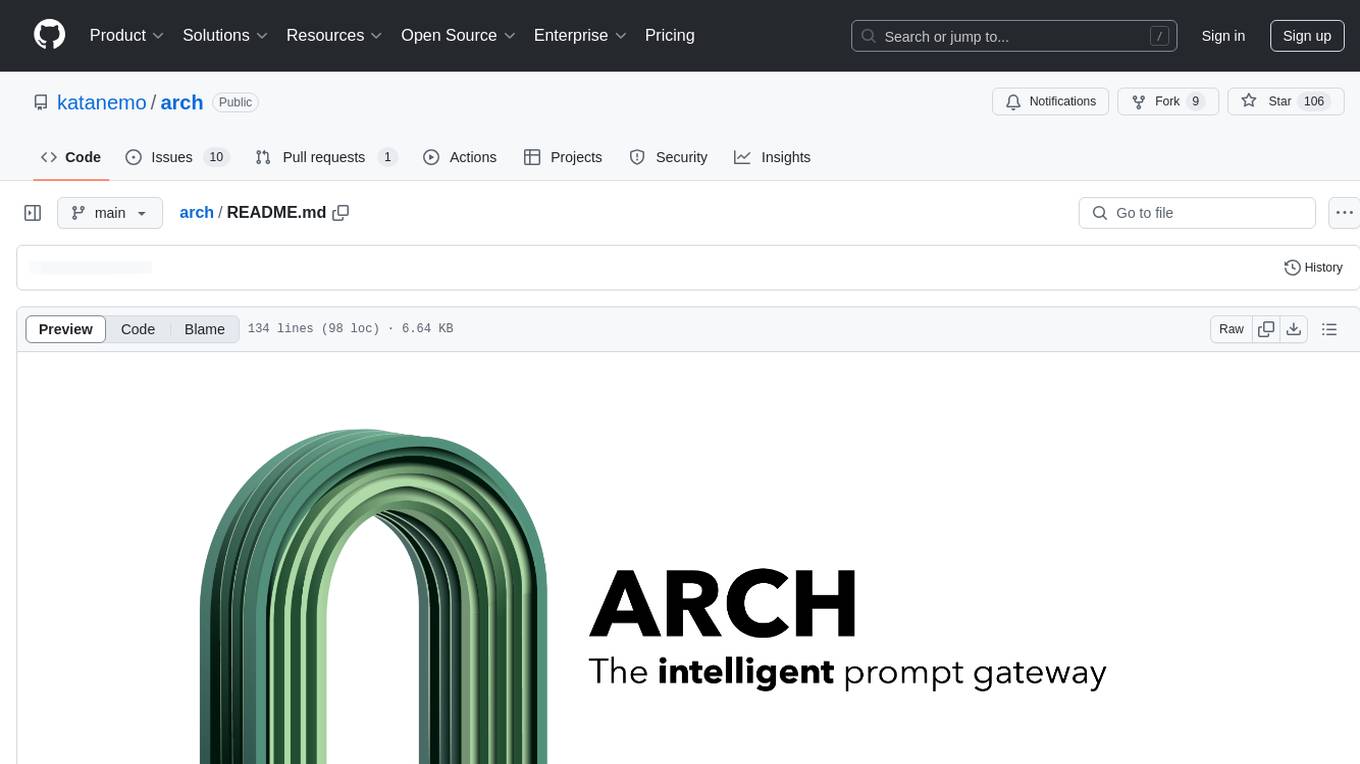
arch
Arch is an intelligent Layer 7 gateway designed to protect, observe, and personalize LLM applications with APIs. It handles tasks like detecting and rejecting jailbreak attempts, calling backend APIs, disaster recovery, and observability. Built on Envoy Proxy, it offers features like function calling, prompt guardrails, traffic management, and standards-based observability. Arch aims to improve the speed, security, and personalization of generative AI applications.
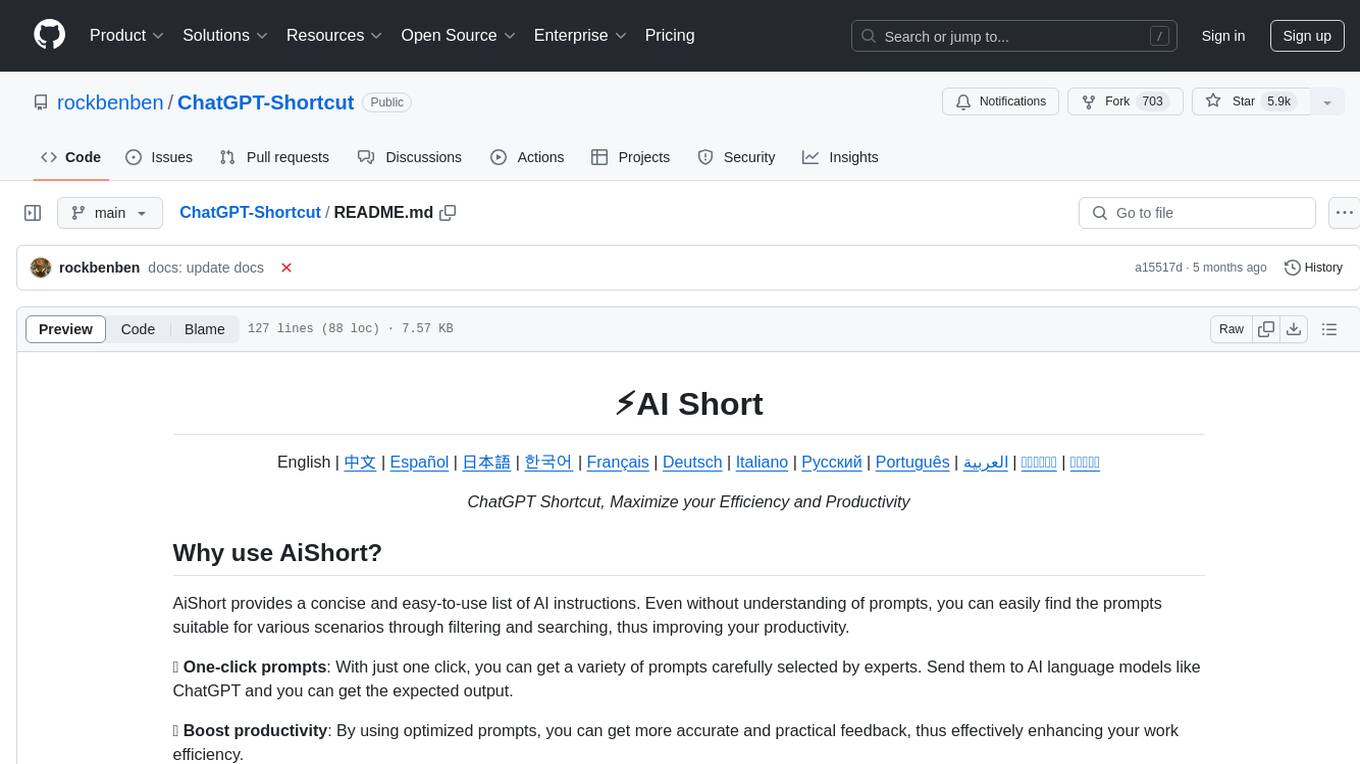
ChatGPT-Shortcut
ChatGPT Shortcut is an AI tool designed to maximize efficiency and productivity by providing a concise list of AI instructions. Users can easily find prompts suitable for various scenarios, boosting productivity and work efficiency. The tool offers one-click prompts, optimization for non-English languages, prompt saving and sharing, and a community voting system. It includes a browser extension compatible with Chrome, Edge, Firefox, and other Chromium-based browsers, as well as a Tampermonkey script for custom domain use. The tool is open-source, allowing users to modify the website's nomenclature, usage directives, and prompts for different languages.
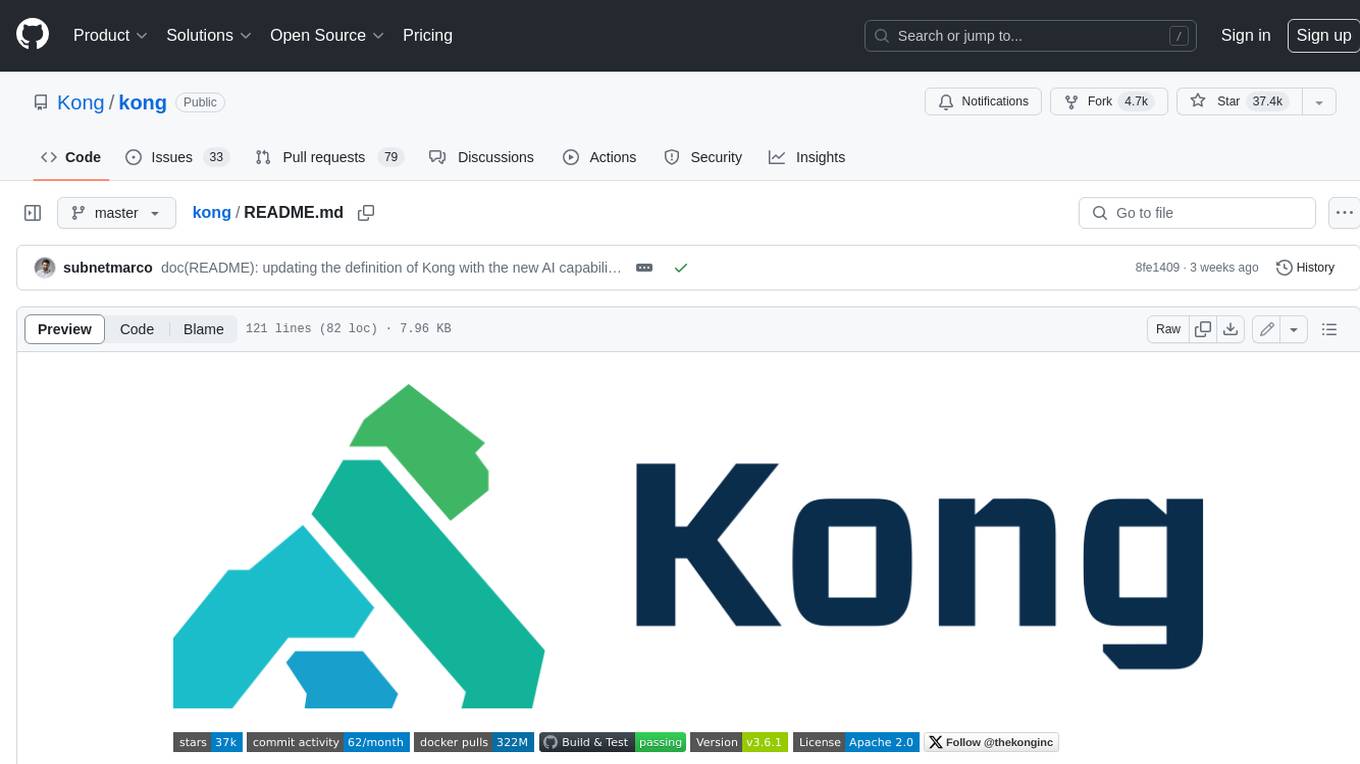
kong
Kong, or Kong API Gateway, is a cloud-native, platform-agnostic, scalable API Gateway distinguished for its high performance and extensibility via plugins. It also provides advanced AI capabilities with multi-LLM support. By providing functionality for proxying, routing, load balancing, health checking, authentication (and more), Kong serves as the central layer for orchestrating microservices or conventional API traffic with ease. Kong runs natively on Kubernetes thanks to its official Kubernetes Ingress Controller.
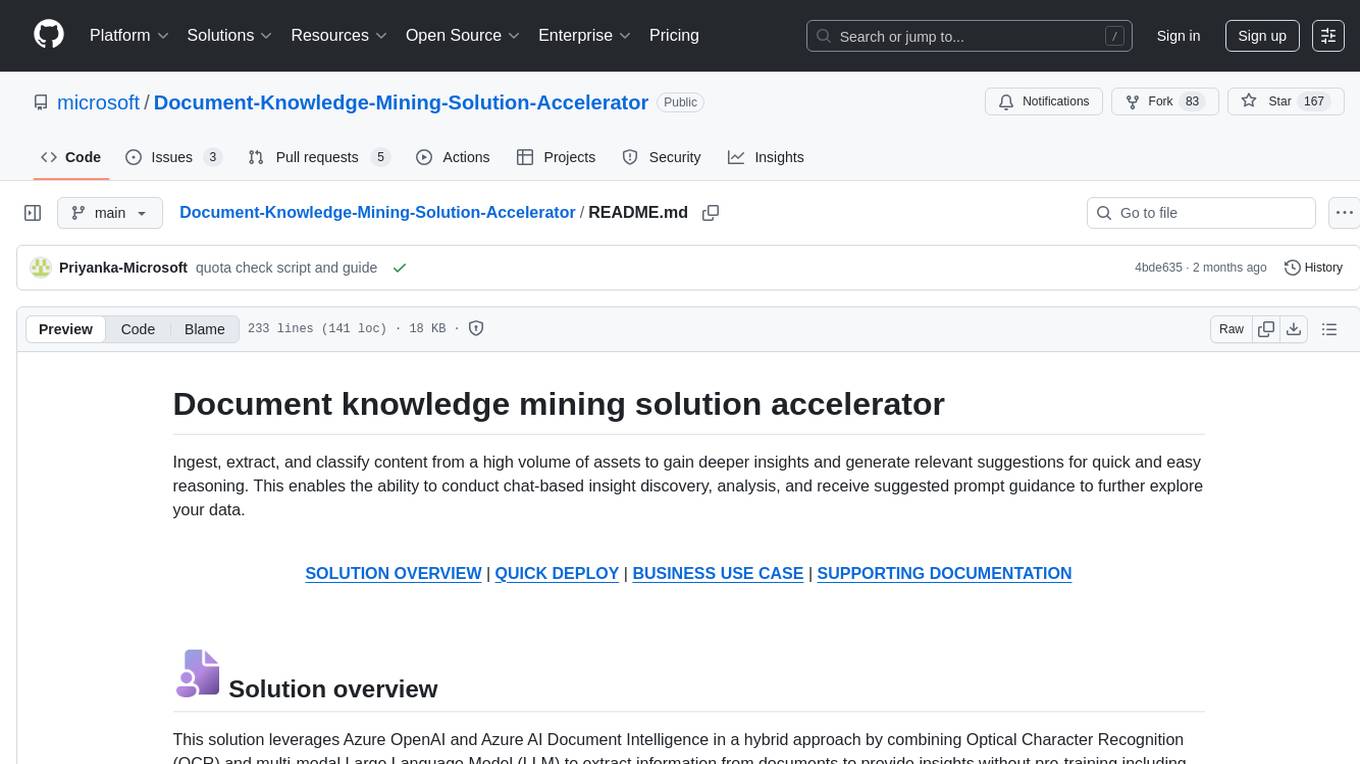
Document-Knowledge-Mining-Solution-Accelerator
The Document Knowledge Mining Solution Accelerator leverages Azure OpenAI and Azure AI Document Intelligence to ingest, extract, and classify content from various assets, enabling chat-based insight discovery, analysis, and prompt guidance. It uses OCR and multi-modal LLM to extract information from documents like text, handwritten text, charts, graphs, tables, and form fields. Users can customize the technical architecture and data processing workflow. Key features include ingesting and extracting real-world entities, chat-based insights discovery, text and document data analysis, prompt suggestion guidance, and multi-modal information processing.
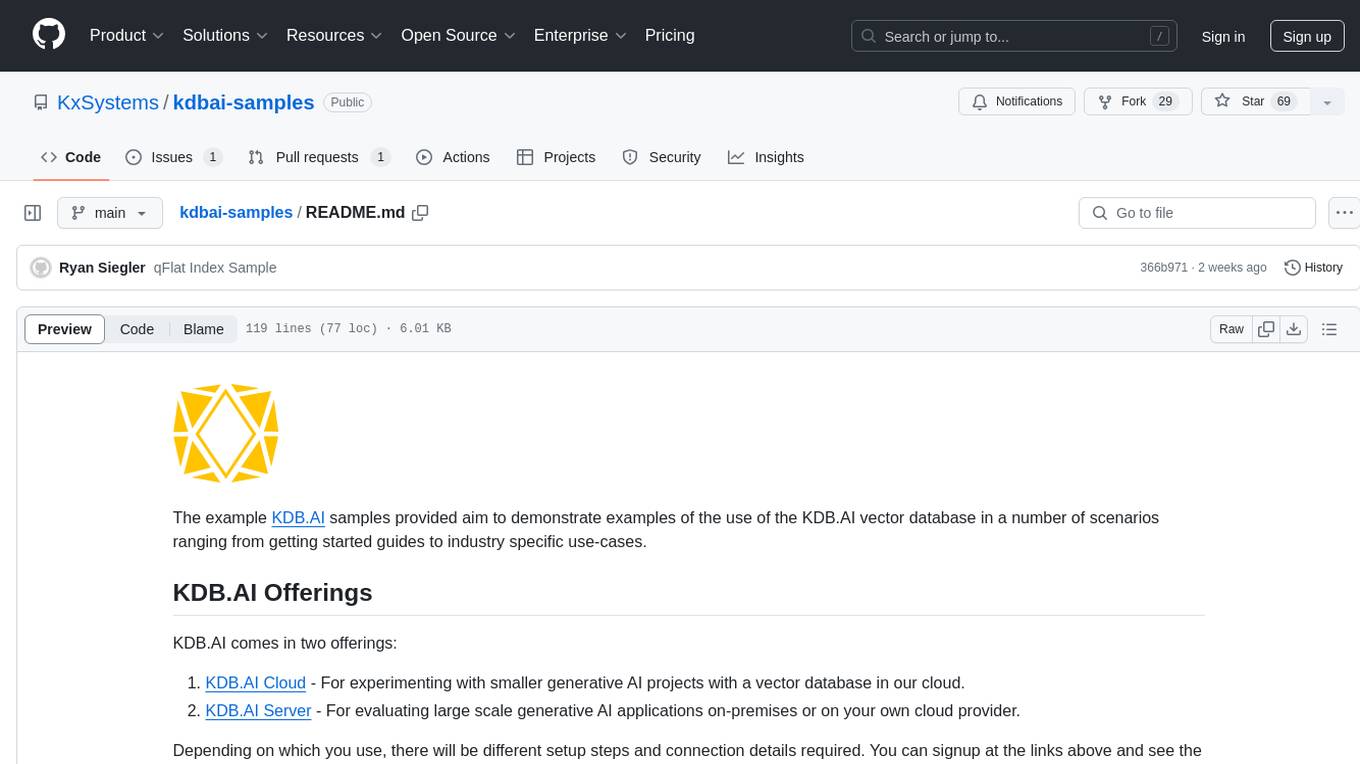
kdbai-samples
KDB.AI is a time-based vector database that allows developers to build scalable, reliable, and real-time applications by providing advanced search, recommendation, and personalization for Generative AI applications. It supports multiple index types, distance metrics, top-N and metadata filtered retrieval, as well as Python and REST interfaces. The repository contains samples demonstrating various use-cases such as temporal similarity search, document search, image search, recommendation systems, sentiment analysis, and more. KDB.AI integrates with platforms like ChatGPT, Langchain, and LlamaIndex. The setup steps require Unix terminal, Python 3.8+, and pip installed. Users can install necessary Python packages and run Jupyter notebooks to interact with the samples.
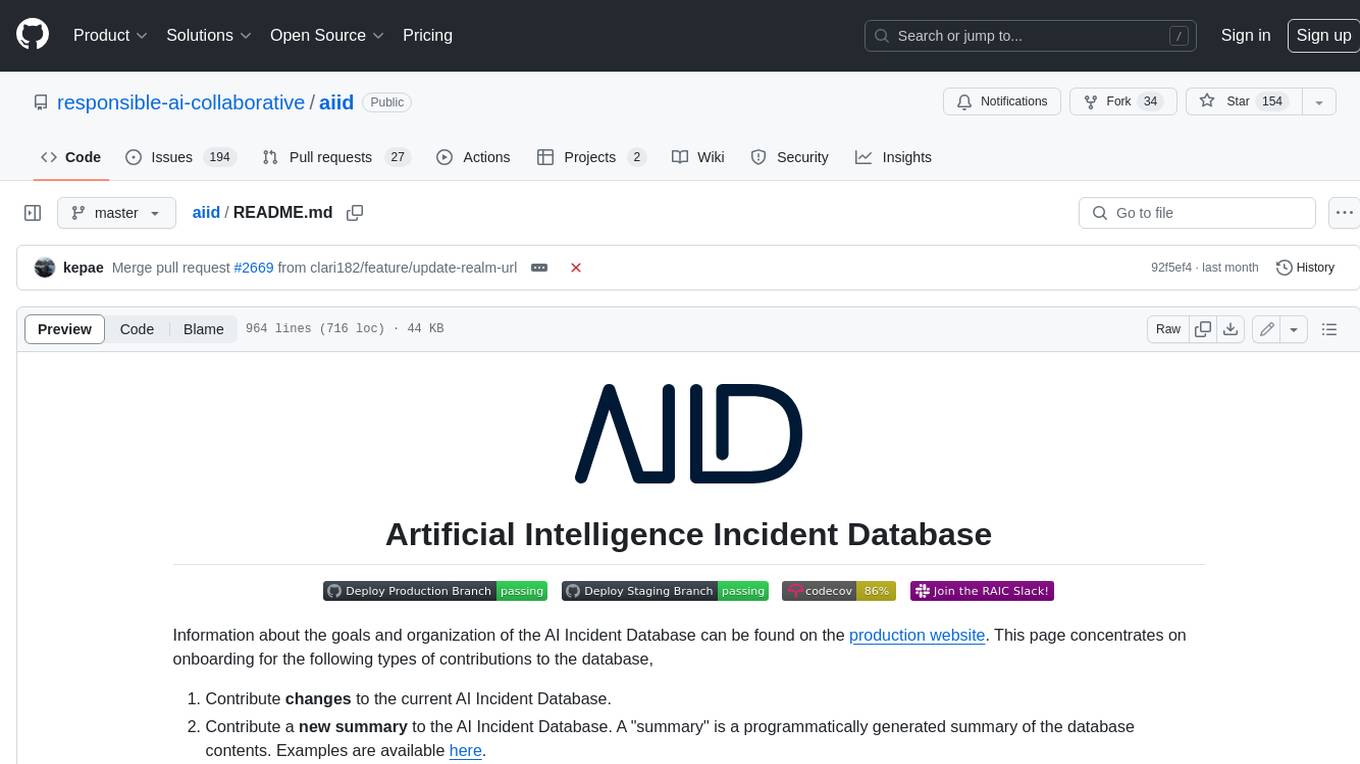
aiid
The Artificial Intelligence Incident Database (AIID) is a collection of incidents involving the development and use of artificial intelligence (AI). The database is designed to help researchers, policymakers, and the public understand the potential risks and benefits of AI, and to inform the development of policies and practices to mitigate the risks and promote the benefits of AI. The AIID is a collaborative project involving researchers from the University of California, Berkeley, the University of Washington, and the University of Toronto.

project_alice
Alice is an agentic workflow framework that integrates task execution and intelligent chat capabilities. It provides a flexible environment for creating, managing, and deploying AI agents for various purposes, leveraging a microservices architecture with MongoDB for data persistence. The framework consists of components like APIs, agents, tasks, and chats that interact to produce outputs through files, messages, task results, and URL references. Users can create, test, and deploy agentic solutions in a human-language framework, making it easy to engage with by both users and agents. The tool offers an open-source option, user management, flexible model deployment, and programmatic access to tasks and chats.
For similar tasks

uuWAF
uuWAF is an industrial-grade, free, high-performance, highly extensible web application and API security protection product that supports AI and semantic engines.
For similar jobs

uuWAF
uuWAF is an industrial-grade, free, high-performance, highly extensible web application and API security protection product that supports AI and semantic engines.
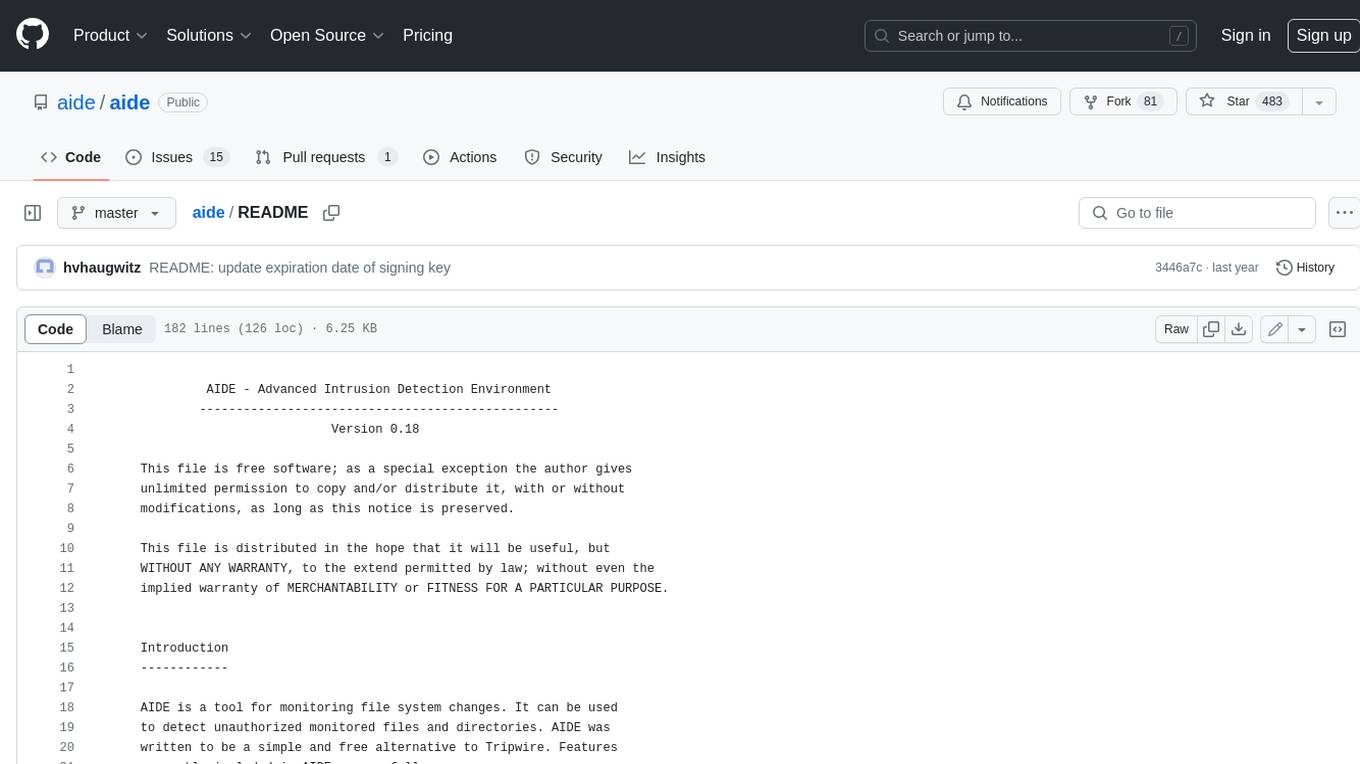
aide
AIDE (Advanced Intrusion Detection Environment) is a tool for monitoring file system changes. It can be used to detect unauthorized changes to monitored files and directories. AIDE was written to be a simple and free alternative to Tripwire. Features currently included in AIDE are as follows: o File attributes monitored: permissions, inode, user, group file size, mtime, atime, ctime, links and growing size. o Checksums and hashes supported: SHA1, MD5, RMD160, and TIGER. CRC32, HAVAL and GOST if Mhash support is compiled in. o Plain text configuration files and database for simplicity. o Rules, variables and macros that can be customized to local site or system policies. o Powerful regular expression support to selectively include or exclude files and directories to be monitored. o gzip database compression if zlib support is compiled in. o Free software licensed under the GNU General Public License v2.
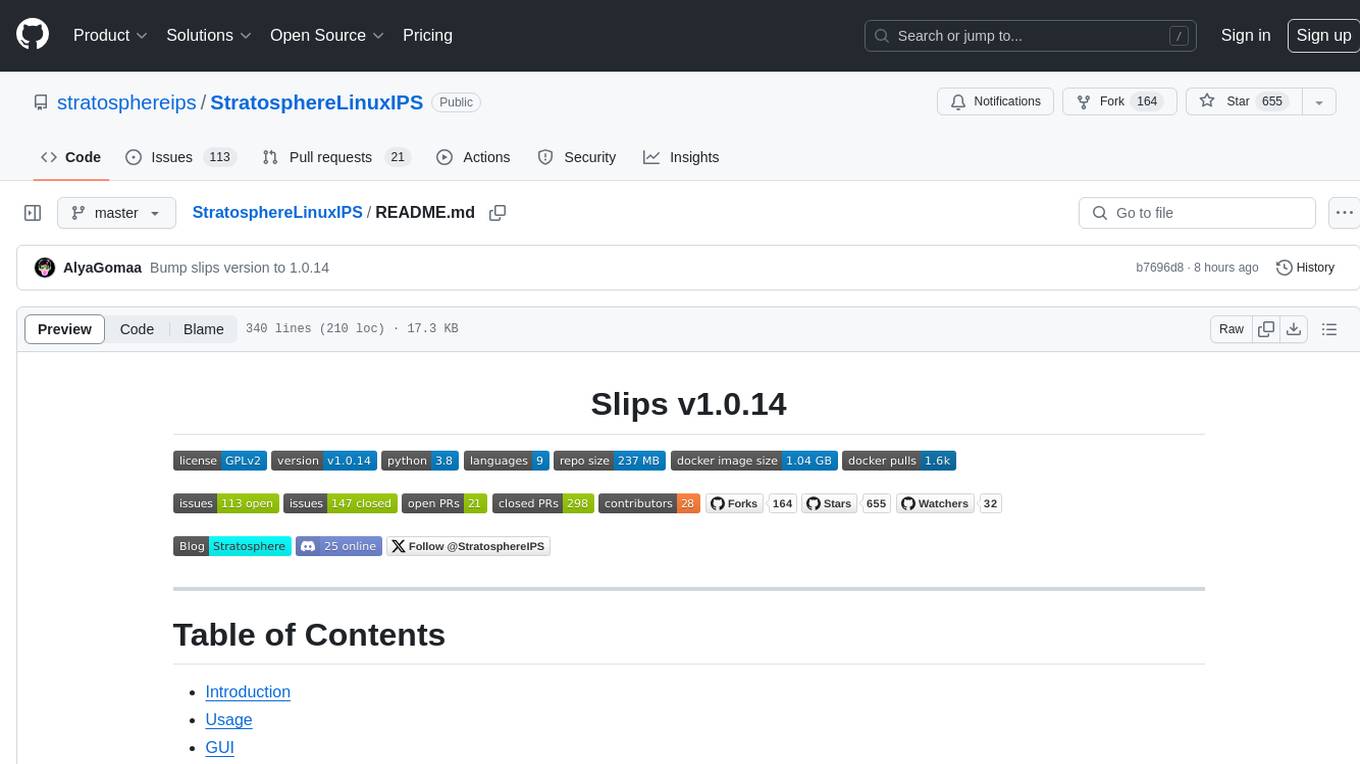
StratosphereLinuxIPS
Slips is a powerful endpoint behavioral intrusion prevention and detection system that uses machine learning to detect malicious behaviors in network traffic. It can work with network traffic in real-time, PCAP files, and network flows from tools like Suricata, Zeek/Bro, and Argus. Slips threat detection is based on machine learning models, threat intelligence feeds, and expert heuristics. It gathers evidence of malicious behavior and triggers alerts when enough evidence is accumulated. The tool is Python-based and supported on Linux and MacOS, with blocking features only on Linux. Slips relies on Zeek network analysis framework and Redis for interprocess communication. It offers a graphical user interface for easy monitoring and analysis.

AutoAudit
AutoAudit is an open-source large language model specifically designed for the field of network security. It aims to provide powerful natural language processing capabilities for security auditing and network defense, including analyzing malicious code, detecting network attacks, and predicting security vulnerabilities. By coupling AutoAudit with ClamAV, a security scanning platform has been created for practical security audit applications. The tool is intended to assist security professionals with accurate and fast analysis and predictions to combat evolving network threats.
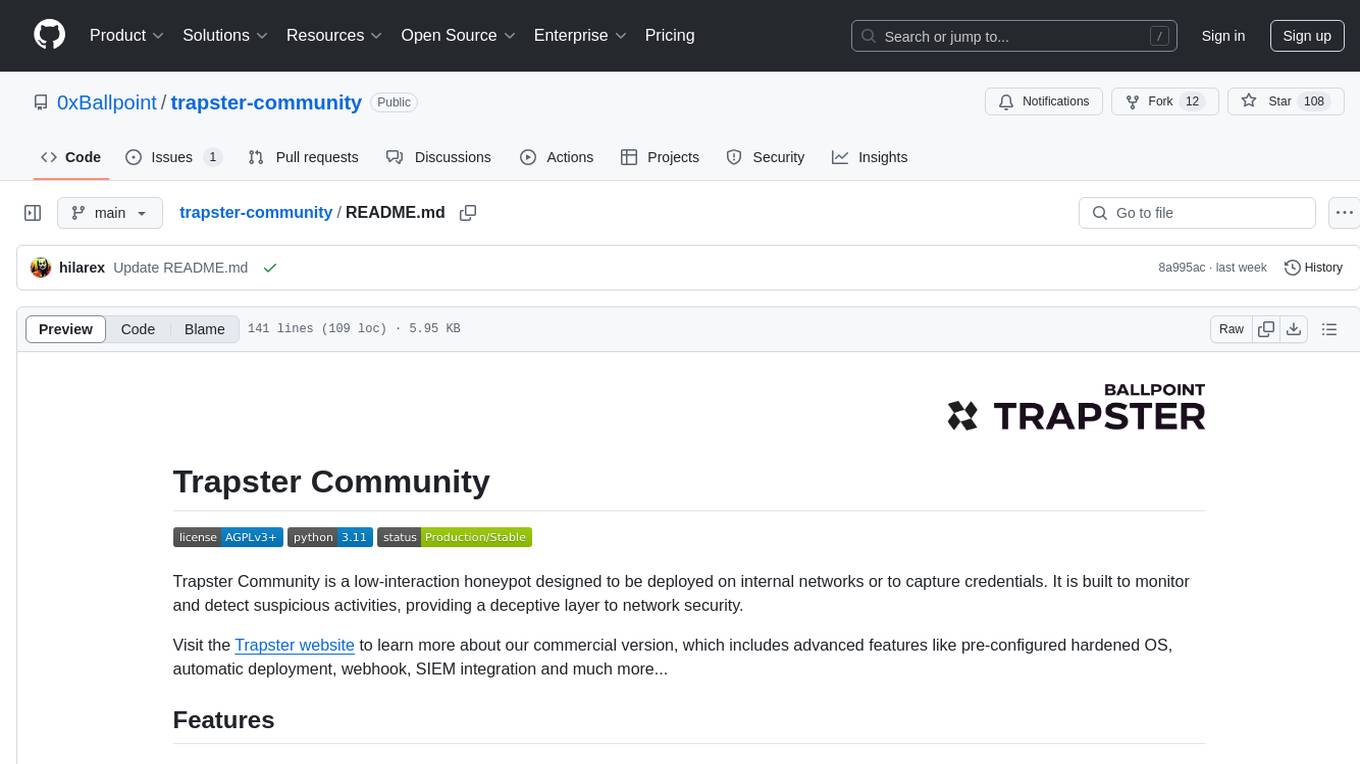
trapster-community
Trapster Community is a low-interaction honeypot designed for internal networks or credential capture. It monitors and detects suspicious activities, providing deceptive security layer. Features include mimicking network services, asynchronous framework, easy configuration, expandable services, and HTTP honeypot engine with AI capabilities. Supported protocols include DNS, HTTP/HTTPS, FTP, LDAP, MSSQL, POSTGRES, RDP, SNMP, SSH, TELNET, VNC, and RSYNC. The tool generates various types of logs and offers HTTP engine with AI capabilities to emulate websites using YAML configuration. Contributions are welcome under AGPLv3+ license.

uusec-waf
UUSEC WAF is an industrial grade free, high-performance, and highly scalable web application and API security protection product that supports AI and semantic engines. It provides intelligent 0-day defense, ultimate CDN acceleration, powerful proactive defense, advanced semantic engine, and advanced rule engine. With features like machine learning technology, cache cleaning, dual layer defense, semantic analysis, and Lua script rule writing, UUSEC WAF offers comprehensive website protection with three-layer defense functions at traffic, system, and runtime layers.

PyRIT
PyRIT is an open access automation framework designed to empower security professionals and ML engineers to red team foundation models and their applications. It automates AI Red Teaming tasks to allow operators to focus on more complicated and time-consuming tasks and can also identify security harms such as misuse (e.g., malware generation, jailbreaking), and privacy harms (e.g., identity theft). The goal is to allow researchers to have a baseline of how well their model and entire inference pipeline is doing against different harm categories and to be able to compare that baseline to future iterations of their model. This allows them to have empirical data on how well their model is doing today, and detect any degradation of performance based on future improvements.
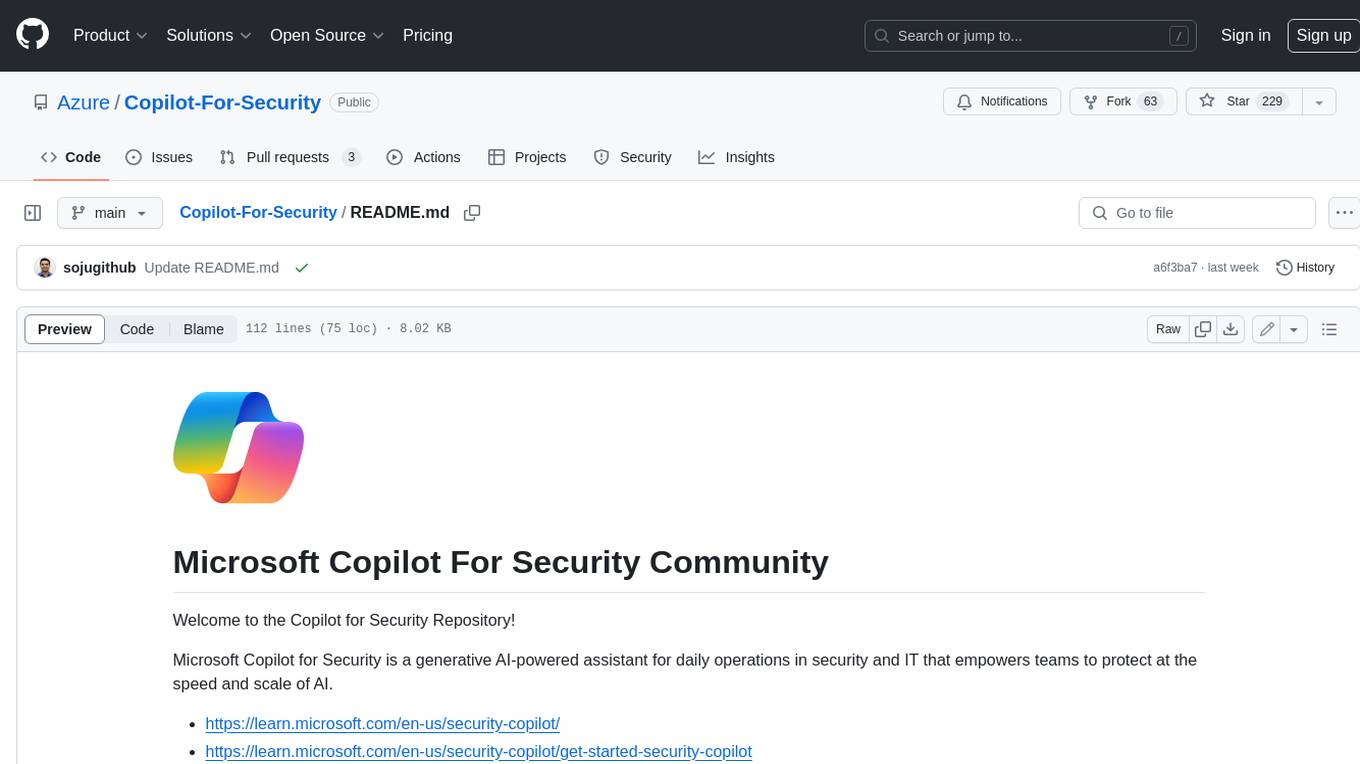
Copilot-For-Security
Microsoft Copilot for Security is a generative AI-powered assistant for daily operations in security and IT that empowers teams to protect at the speed and scale of AI.


